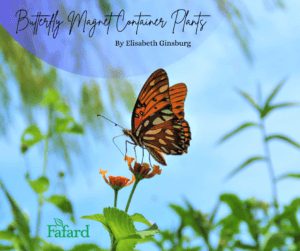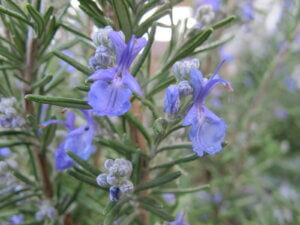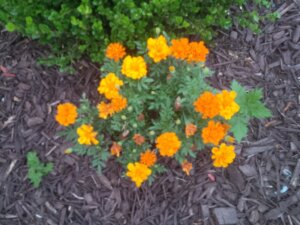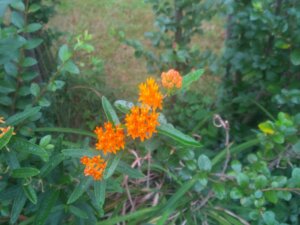
Butterflies, along with other winged beauties like skippers and moths, bring magic to the garden with their colorful wings and intricate flight patterns. But the magic doesn’t stop there. Butterflies are among the VIPs of the pollinator world, transferring pollen as they swoop from flower to flower in search of nectar.
One of the best things about butterflies is that they don’t care whether nectar-bearing plants are growing in garden beds, containers or window boxes. That is welcome news for people with limited spaces.
Nectar is the Name of the Game
To draw butterflies to your containers or window boxes, choose plants, including annuals, perennials and shrubs that are rich in nectar. Butterfly—attracting annuals and reblooming perennials may stay in the same containers all season long, flowering from spring until frost. Perennials can also be grown that way, but some gardeners prefer to plant them in liner containers that can be dropped into decorative planters and boxes and then changed out when flowering is over. An alternative strategy is to use large containers for mixed plant arrangements, incorporating both annuals and perennials for more bloom and prolonged interest.

Butterflies in the Name
Some of the best butterfly plants have “butterfly” in their names. Butterfly bush (Buddleia) is a great example. Traditional butterfly bushes are shrubs that grow anywhere from 48 to 72 inches tall, but breeders have come up with smaller specimens, like little ‘Pink Microchip’, with soft pink flowerheads and an 18 to 24-inch height and spread. Reblooming from late spring or early summer onward, the tiny, fragrant flowers are a butterfly’s delight and may also attract hummingbirds. The ‘Pugster’ series of small buddleias offers blooms in shades of purple, pink and white, all of which top out at 24 inches tall and wide—perfect for medium to large containers. Butterflies love the sun and so do butterfly bushes, so pick a bright location for your containers.

Perennial native butterfly weed or Aesclepias tuberosa, with its brilliant orange flowers, is both a host and food plant for monarchs, and will do well in container positioned in the sunshine. Since its good looks last only as long as the flowers, it is best grown in a liner, or a pot that can be moved to the back of the container array when the plant is not in bloom.
Irresistible Mint
Members of the mint or Lamiaceae family are irresistible to butterflies, with the added attraction of toughness and ease of culture. North American native Agastache or hummingbird mint is a great addition to any sunny container garden, and some varieties are perfect for small spaces. Little agastaches in the ‘Poquito’ series boast minty-smelling foliage and sprightly flower spikes that reach 11 to 14 inches tall in shades that include butter yellow and lavendar, with blooms appearing regularly in the summer and early fall.
Catmints (Nepeta) are virtually indestructible, flowering in flushes throughout the summer, with gray-green aromatic foliage and soft blue spikes of tiny flowers. Container growers will appreciate compact varieties like ‘Little Trudy’, with deep blue-purple flowers and a maximum height of ten inches. Light shearing after flowering will promote regrowth and additional blooms.
Smells Good, Tastes Good, Looks Good
If you want to combine pollinator attraction with culinary desirability, fill your containers with another mint family member–rosemary (Rosemarinus officionalis). Traditionally this shrubby, aromatic herb grows to impressive size. It can be grown in containers in topiary form, but for gardeners limited by both space and time, a better choice is a dwarf variety like ‘Blue Boy’, which grows only six to eight-inches tall, with a wider spread—about 15 to 18 inches. This trait makes the plant good for window boxes and hanging baskets, as well as taller containers. The flowers are light blue and borne in abundance. Rosemary is generally not hardy in cold winter climates. Container culture makes the plants easier to bring indoors when frost threatens.

A Butterfly Banquet of Annuals
There is a reason why traditional annual flowers like zinnias, marigolds and sunflowers have withstood the test of time and the ebb and flow of horticultural fashion. They are easy to grow from starter plants or seeds, bloom over a long season, and require little care. They also feature flowers that are rich in nectar, which means that your garden will also be rich in butterflies and other pollinators. For containers, choose varieties on the shorter side (or use large containers for traditional tall varieties). Zinnias like the ‘Thumbelina’ and ‘Lilliput’ series offer a rainbow of butterfly-attracting colors and plants that grow only 12 to 18-inches tall.
For something small but flashy, try dwarf marigolds like ‘Bolero’, with red and yellow-splashed petals on plants that grow only 12-inches tall. Use them alone in single-variety containers or combine with other, less flamboyant varieties for high contrast in small space.

We think of sunflowers as the giants of the summer garden, but smaller varieties are easy to grow in containers. ‘Sunray Yellow’ features the traditional golden-yellow petals surrounding big, dark seedheads. It rises to only 20 to 22-inches tall.
And don’t forget petunias—old fashioned and reliable, they are universally available and loved by butterflies. Aim for newer varieties with blooms that are less likely to “ball-up” when it rains. As with all annuals, deadhead faithfully for best results.

Health and Sustainability
Container gardens can be every bit as beautiful as in-ground landscapes, but require a slightly different approach to care. Regular watering is key, especially in hot weather. For the sake of plant health and sustainability, use a water-retentive planting compound like Sunshine® Black Bear® Indoor & Outdoor Growing Mix. Regular feeding, especially for annuals, is also important. Use a balanced commercial product, diluted, if necessary, according to manufacturers’ instructions. Eliminate or minimize the use of pesticides. In a healthy ecosystem birds and other pest predators will take care of the majority of insects that attack plants.

Healthy Plants, Healthy Pollinators, Healthy Humans
Pollinators, including butterflies, are essential, not only to flowers, but to all food crops, and ultimately to human survival. Do your part for beauty and sustainability by creating great container gardens full of flourishing butterfly-friendly plants.

